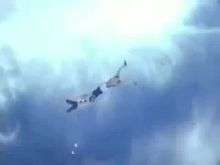Banzai skydiving

Banzai Skydiving is a form of skydiving that originated in Japan. The Banzai skydive consists of flying to a jump altitude of 10,000 ft. (3,000 m). Before exiting, the diver throws his or her parachute out the airplane door, waits two seconds, and then jumps after it. To be successful, the skydiver must secure the parachute and glide to the projected landing zone.
The banzai skydiver wears a special harness that attaches to a cord extending from the parachute.[1] The cord can be clearly seen in Andreas Dachtler's jump video taken in Southeast Europe. This ensures the skydiver can safely recover the parachute. Otherwise, the normal harness would require a thread through. This would be impossible while in free fall.
The banzai skydive is the most dangerous category in the Guinness Book of World Records, according to Editor Craig Glenday.[2] Yasuhiro Kubo took the challenge on September 2, 2000. Kubo waited an 50 seconds after jumping before regaining and deploying his parachute. This won him a place in the Guinness World Records.
The Banzai skydiving category is still accepted in the Guinness Book of World Records. Guinness cannot accept a record claim that is likely to put people at risk other than the person attempting the world record. As long as the Banzai skydive guidelines are followed, nobody is at risk. The guidelines state that the jump must be done away from public places. There are currently no reported banzai skydiving deaths.
Sources
- Chuteless Jump, Skydiving Without Parachute
- The Guinness Book of World Records Editor Answers Your Questions